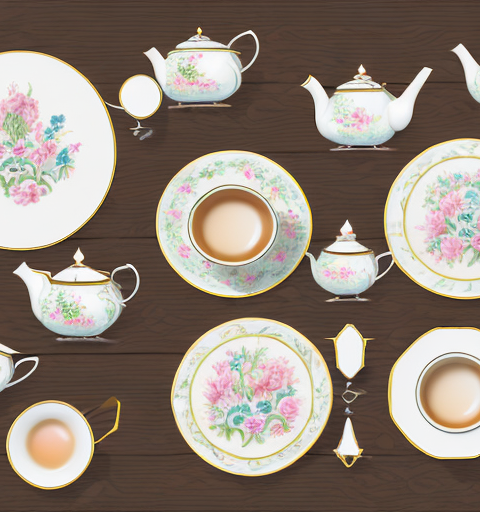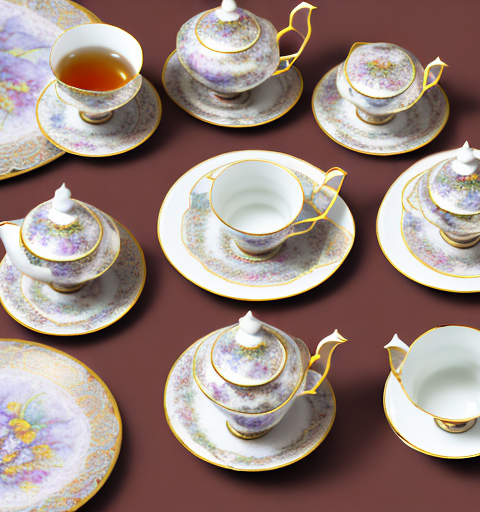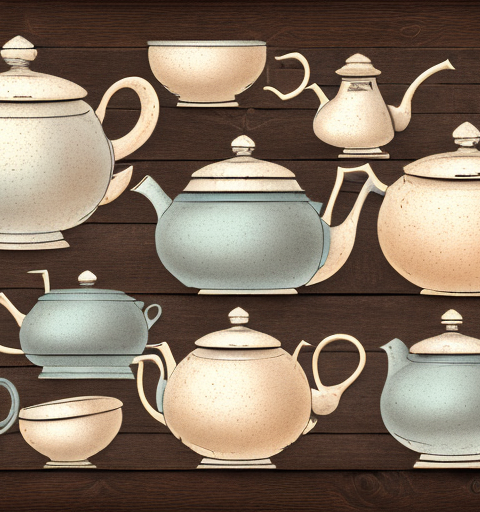Tea lovers are often fascinated by the intricate details that contribute to the perfect cup of tea. From the type of tea leaves to the water temperature, every element is carefully considered. One factor that is sometimes overlooked, but has a profound impact on the infusion process, is the shape of the teapot. In this article, we will delve into the science behind tea infusion and explore the various ways in which the shape of a ceramic teapot can affect the flavors, aroma, strength, and overall brewing experience.
The science behind tea infusion
Before we dive into the role of teapot shape in the infusion process, let’s briefly discuss the science behind tea infusion. When tea leaves are steeped in hot water, a chemical reaction occurs where the water molecules interact with the compounds in the leaves, extracting their flavors, aromas, and beneficial properties. This process is influenced by several key factors, including water temperature, steeping time, and the surface area of the leaves exposed to the water. Now, let’s explore how the shape of a ceramic teapot can impact these factors and ultimately affect the quality of your brew.
One important factor to consider when it comes to teapot shape is the distribution of heat. Different teapot shapes can affect how heat is distributed during the infusion process. For example, teapots with a wider base and shorter height tend to distribute heat more evenly, ensuring that the water temperature remains consistent throughout the brewing process. On the other hand, teapots with a narrower base and taller height may result in uneven heat distribution, leading to variations in water temperature and potentially affecting the extraction of flavors from the tea leaves.
Exploring the impact of teapot shape on tea flavors
Tea enthusiasts will agree that the flavor profile of a brew is a crucial aspect of the tea-drinking experience. Believe it or not, the shape of your teapot can influence the taste of your tea. Why is that? It all comes down to how the hot water interacts with the tea leaves during the steeping process. Certain teapot shapes, such as wide and shallow ones, allow the water to come into greater contact with the leaves, resulting in a more pronounced and full-bodied flavor. On the other hand, tall and narrow teapots may result in a more delicate and nuanced flavor, as the water interacts with a smaller surface area of the leaves. Of course, personal preference plays a role here, but it’s intriguing to consider how teapot shape can impact the taste of your favorite tea.
Additionally, the material of the teapot can also affect the flavor of the tea. Porcelain teapots, for example, are known for their ability to retain heat and distribute it evenly, which can enhance the extraction of flavors from the tea leaves. On the other hand, clay teapots, such as those made from Yixing clay, are highly porous and can absorb some of the tea’s oils and flavors over time, resulting in a unique and seasoned taste. Glass teapots, on the other hand, allow you to visually appreciate the color and clarity of the tea, but may not retain heat as well as other materials. Ultimately, the choice of teapot material, in combination with its shape, can contribute to the overall taste experience of your tea.
Unraveling the relationship between ceramic teapot shape and infusion efficiency
Efficiency is a critical aspect to consider when brewing tea, and the shape of your ceramic teapot can have a significant impact on how efficiently the tea leaves infuse. Teapots with a wide base and narrow neck, known as “pear-shaped” or “gaiwan” teapots, are favored by many tea connoisseurs for their exceptional infusion efficiency. This shape allows for optimal water circulation, ensuring that the tea leaves are evenly exposed to the hot water, resulting in a more uniform extraction of flavors. Conversely, teapots with a wide and shallow shape, such as a “Yixing” teapot, may not offer the same level of infusion efficiency. It’s important to consider your desired brewing results when choosing a teapot with regards to efficiency.
How does the design of a teapot affect the extraction of flavors?
Teapot design goes hand in hand with shape when it comes to the extraction of flavors. The design elements, such as the presence of a strainer or infuser, can influence how the tea leaves interact with the water during the infusion process. Teapots with built-in infusers allow for a more filtered brewing experience, as the leaves are contained within the infuser, preventing any unwanted particles from entering the cup. On the other hand, teapots without infusers may allow for a more immersive brewing experience, as the leaves have direct contact with the water. It’s worth noting that the design of the teapot can also impact the ease of cleaning and maintenance, which should be considered when choosing the perfect teapot.
The role of geometry in tea brewing: a closer look at ceramic teapots
The geometry of a ceramic teapot is an aspect that should not be overlooked. While the overall shape is important, it’s also worth considering the proportions and angles within the teapot. For example, the angle of the spout can greatly impact the pouring precision and the retention of flavors. A wider spout may allow for a faster pour but could result in potential spillage and a decrease in flavor retention. Conversely, a narrower spout may offer more control and precision when pouring, ensuring that every drop finds its way into your cup. These small details contribute to the overall functionality and performance of a teapot.
Understanding the influence of teapot shape on tea strength and aroma
The strength and aroma of your tea can be influenced by the shape of your ceramic teapot. Teapots with a large surface area exposed to the water, such as those with wide and shallow designs, tend to brew stronger tea. This is because more water comes into contact with the tea leaves, resulting in a higher concentration of flavors and a more intense aroma. Conversely, teapots with a smaller surface area of exposure, like tall and narrow designs, may produce a milder brew. The shape of the teapot can have a significant impact on the strength and aroma of your tea, allowing you to tailor your brewing experience to match your preferences.
The art and science of choosing the right teapot for optimal infusion
Choosing the right ceramic teapot for optimal infusion is a balance between art and science. On one hand, you have the artistic aspect, where the shape, design, and aesthetics of the teapot contribute to the overall tea-drinking experience. On the other hand, you have the scientific aspect, where the shape and design elements directly influence the infusion process. When selecting a teapot, it’s essential to consider both aspects and find a teapot that aligns with your personal preferences while also enhancing the quality of your brew. It’s a beautiful synergy between form and function.
Enhancing your tea experience with the right ceramic teapot shape
While the shape of a ceramic teapot may seem like a minor detail in comparison to other factors, it has the potential to enhance your tea experience significantly. The right teapot shape can bring out the best qualities of your favorite tea, allowing you to savor the nuanced flavors and aromas. Experimenting with different teapot shapes can be a delightful journey of discovery, as you explore the various characteristics each shape offers. Whether it’s a wide and shallow teapot for a robust brew or a tall and narrow one for a delicate infusion, the right teapot shape can elevate your tea experience to new heights.
Investigating the effects of different teapot shapes on tea brewing time
Tea brewing time is a critical factor that determines the strength and flavor profile of your cup of tea. Interestingly, the shape of your ceramic teapot can influence the brewing time. Teapots with larger surface areas, such as wide and shallow designs, may result in a shorter brewing time, as the water interacts more readily with the tea leaves. Conversely, teapots with smaller surface areas, like tall and narrow designs, may require a longer brewing time for the water to fully extract the flavors from the leaves. By understanding the relationship between teapot shape and brewing time, you can fine-tune your brewing process to achieve the desired strength and taste.
Unlocking the secrets of flavor extraction: a study on ceramic teapot shapes
While much is still being explored and studied in the realm of tea infusion, research has shown that the shape of a ceramic teapot plays a significant role in flavor extraction. Several scientific studies have focused on analyzing the impact of teapot shapes on the chemical composition and sensory properties of tea. These studies have highlighted the variations in flavor profiles, caffeine levels, and antioxidant content obtained from different teapot shapes. By investigating the secrets of flavor extraction through these studies, we gain a deeper understanding of how teapot shapes can shape our tea-drinking experience.
Factors to consider when selecting a ceramic teapot for perfect infusion
When selecting a ceramic teapot for the perfect infusion, several factors should be considered. Firstly, assess your brewing preferences. Do you prefer a stronger or milder brew? This will guide you in selecting a teapot shape that aligns with your desired tea strength. Additionally, consider the specific type of tea you enjoy most. Different types of tea may benefit from different teapot shapes, so take some time to research which shapes are most commonly used for your favorite tea. Lastly, don’t forget to prioritize your personal preferences in terms of aesthetics, usability, and maintenance. Overall, finding the perfect ceramic teapot for your infusion needs is a delightful process of discovery and thoughtful consideration.
Exploring the aesthetics and functionality of various ceramic teapot shapes in tea brewing
The world of ceramic teapots is a treasure trove of diverse shapes, each with its own unique aesthetics and functionality. From elegant and curvaceous designs to more minimalist and angular ones, there is no shortage of options for tea enthusiasts to explore. As mentioned earlier, teapot shapes can impact the flavor, aroma, and infusion process, but they can also contribute to the overall tea-drinking experience in terms of visual appeal, ergonomics, and ease of use. By taking the time to explore the vast array of ceramic teapot shapes available, you can find the perfect balance between aesthetics and functionality to enhance your tea brewing rituals.
The impact of teapot design on heat retention and even distribution during infusion
Heat retention and even distribution are vital aspects of tea brewing, and the design of a ceramic teapot can have a significant impact in these areas. Teapots with thicker walls and lids are known for their superior heat retention properties, keeping your tea hotter for longer durations. Additionally, teapots with well-designed spouts and handles can ensure even distribution of the tea into your cup, minimizing the risk of spills and maximizing the extraction of flavors. Pay attention to these design elements when choosing a ceramic teapot to optimize heat retention and achieve a consistent and enjoyable brewing experience.
How does the shape of a ceramic teapot influence tea steeping dynamics?
The shape of a ceramic teapot can influence the dynamics of tea steeping, impacting factors such as water circulation and tea leaf expansion. Teapots with wider bases and narrower necks promote better water circulation during infusion, ensuring that the tea leaves are evenly exposed to the hot water. This facilitates a more efficient and thorough steeping process. Additionally, teapots with spacious interiors allow for better expansion of the tea leaves as they unfurl, resulting in a more robust infusion of flavors. The shape of the teapot plays a critical role in creating the ideal environment for tea steeping dynamics, ultimately enhancing the quality of your brew.
Improving your brew: understanding how different ceramic teapots affect infusion outcomes
If you’re looking to improve your brewing skills and enhance the quality of your tea, understanding how different ceramic teapots affect infusion outcomes is key. As we’ve explored throughout this article, teapot shape can influence factors such as flavor, strength, aroma, brewing time, and more. By experimenting with various teapot shapes and keeping a record of your observations, you can develop a deeper understanding of how different teapots impact the characteristics of your brew. This knowledge empowers you to make informed choices when selecting a teapot and refine your brewing techniques to achieve the perfect cup of tea every time.
Does a wider or narrower spout affect pouring precision and flavor retention?
The spout of a ceramic teapot plays a crucial role in pouring precision and flavor retention. The width of the spout can influence the rate at which the tea flows, affecting your ability to control the pour and avoid spillage. A wider spout may offer a faster pour but could also result in less control and potentially compromise flavor retention. On the other hand, a narrower spout allows for more precision and control over the flow, ensuring that every drop makes its way into your cup while minimizing the risk of losing essential aromas and flavors. Consider your pouring preferences and desired flavor retention when selecting a teapot with regards to the spout width.
Comparing traditional and modern ceramic teapots: which shape reigns supreme in infusion?
The world of ceramic teapots embraces both traditional and modern designs, each with its own set of characteristics and benefits. Traditional teapots, often inspired by historical tea-drinking traditions, come in a variety of shapes and are highly regarded for their ability to preserve the authenticity of the tea-drinking experience. Modern teapots, on the other hand, often incorporate contemporary design elements and advanced materials to offer enhanced functionality and aesthetics. When comparing traditional and modern ceramic teapots, it ultimately comes down to personal preference. Embrace your unique taste and brewing style as you explore the diverse range of shapes available in both traditional and modern teapots.
Exploring the cultural significance of specific ceramic teapot shapes in different tea-drinking traditions.
Ceramic teapots are deeply intertwined with tea-drinking traditions around the world, each culture contributing its unique shapes and designs. For example, the classic “gaiwan” teapot shape holds immense cultural significance in Chinese tea ceremonies, symbolizing simplicity, elegance, and the pursuit of perfection. In Japan, the “Kyusu” teapot with its handle on the side allows for ease of pouring during traditional Japanese tea ceremonies. By exploring the cultural significance of specific teapot shapes, we gain a greater appreciation for the rich history and traditions associated with tea-drinking. Recreating these cultural experiences through the vessels we use adds a sense of heritage and authenticity to our tea journeys.
Choosing the perfect ceramic teapot for your favorite type of tea: an exploration based on shape
Selecting the perfect ceramic teapot for your favorite type of tea involves a delightful exploration based on shape. Different types of tea may benefit from specific teapot shapes, which highlight their unique flavors and characteristics. For example, a wide and shallow teapot may be ideal for brewing black teas, allowing for ample extraction of bold flavors. On the other hand, delicate green or white teas may be better suited to tall and narrow teapots, allowing for a more nuanced and gentle infusion. By understanding the specific characteristics and requirements of your favorite tea, you can choose a teapot shape that enhances its inherent qualities, resulting in a truly harmonious tea-drinking experience.






